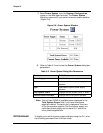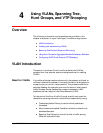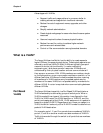
4-2 Avaya P550R, P580, P880, and P882 Multiservice Switch User Guide, Version v5.3.1
Chapter 4
Advantages with VLANs:
■ Segment traffic and usage patterns in a manner similar to
creating subnets and segments in traditional networks.
■ Reduce the cost of equipment moves, upgrades, and other
changes.
■ Simplify network administration.
■ Create logical workgroups for users who share the same system
resources.
■ Users not required to share the same physical location.
■ Reduce the need for routing to achieve higher network
performance and reduced costs.
■ Control or filter communication among broadcast domains.
What is a VLAN?
The Avaya Multiservice Switch has the ability to create separate
logical LANs on the same physical device. These logical segments are
referred to as Virtual LANs (VLANs).VLANs are typically groups of
users with similar job functionality (i.e. sales, marketing,
engineering etc.) and share common resources. VLANs are not
constrained by their physical location and can communicate as if
they were on a common LAN. VLAN members can reside on single
or multiple ports on one or more media modules on a switch, or on
different switches. VLANs are limited broadcast domains, meaning
all members of a VLAN receive every broadcast packet seen by
members of the same VLAN, but not packets sent by members of a
different VLAN. A router is required when communicating between
different VLANs.
Port Based
VLANS
The Avaya Multiservice switch is a Port Based VLAN architecture.
VLAN membership is defined by groups of switch ports. When a
VLAN is created three types of information is configured for that
VLAN, the VLAN name, the VLAN Identifier or VLAN ID, and the
switch ports assigned to that VLAN. VLAN assignment of a packet is
based on a global VLAN ID. Regardless of any name you assign to a
VLAN, the switch looks only at the VLAN ID number to determine a
packet’s VLAN destination.
For example, ports 1, 2, and 3 on a module are members of VLAN A,
ports 4, 5, and 6 on another module are also members of VLAN A.
Traffic is forwarded through the switch to all ports that are members
of VLAN A.


















